Metal Inert Gas (MIG) welding is a gas metal arc welding (GMAW) process that uses a consumable electrode.
Tungsten Inert Gas (TIG) welding on the other hand is a welding process that uses a non-consumable electrode.
Both utilize inert gases as shields to prevent welds from oxidation and contamination.
Advantage Of TIG Welding
- Environmentally friendly: Compared to MIG welding, TIG is environmentally friendly because it does not utilize electrodes.
- Aesthetics: because it utilizes a non-combustible electrode, TIG welding gives clean welds that do not have fillers with reliable joints.
- Precise and accurate: this is because TIG welding can be used in both heterogeneous and homogeneous modes making it suitable for autogenous welding.
- Lower maintenance and operational cost: TIG welding can be used either in DC or AC polarity making it easy to operate and also maintain.
- Operational control: It is easy to operate TIG welding modes compared to MIG welding. This is because one does not need to replace electrodes while welding.


Disadvantage Of TIG Welding
- Expensive: TIG welding is expensive because it has a lower deposition compared to MIG welding. The raw materials used for TIG welding are also expensive.
- Clean surface: TIG welding requires clean surfaces and is easily prone to contamination.
- Experienced operator: Unlike MIG welding, TIG welding requires a higher level of experience to operate.
- Tedious: operating TIG welding requires tedious operation while the welding process itself takes a long time to accomplish.
- Diversity: TIG welding is majorly limited to thicker materials compared to MIG welding which can be used in a wide range of materials.
Advantage Of MIG Welding
- Speed: MIG welding involves the continuous running of the welding process and also runs for a longer time compared to TIG welding.
- Diversity: MIG vs TIG welding aluminum/stainless steel, MIG welding can be utilized in a wide range of materials such as steel, stainless steel, or aluminum.
This makes it ideal for heavy-duty structural plates and a superior choice.
- Ease: it is easy to learn how to use MIG welding compared to other modes of welding.
Its ease of use makes MIG welding one of the most common welding methods.
- Cost: Compared with other welding processes, MIG welding is cost-effective because it is fast, efficient, effective, and gives out quality output.


Disadvantage Of MIG Welding
- Weak joints: because of the application of electrodes between the different materials being welded, MIG welding gives weak joints.
- Reliability: MIG welding has unstable electric arc stability thus less reliable compared to TIG welding.
- Environment friendliness: MIG welding produces fumes and smoke thus making it environmentally unfriendly.
- Rust: most of the welded parts using the MIG welding process rust in due course of time.
- Burns; some thin materials can be completely burned or destroyed by the MIG welding process.
- Delicate; MIG welding process utilizes shielding gases that usually require to be stored indoors.
How MIG Vs. TIG Work

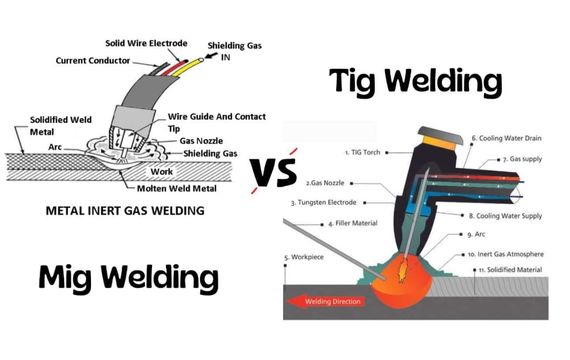
MIG and TIG welding processes have different working processes and are used in different applications.
The different working processes are discussed below.
MIG Process
The MIG welding process requires an inert gas supply that is used to supply gas to the gas nozzle. The inert gas helps to melt the consumable electrode.
This electrode is continuously fed into the contact tube.
The inert gas supplied to the gas nozzle acts as a shield and protects the arc. Oxygen or nitrogen is the commonly used gas for MIG welding processes.
The MIG welding process is a semi-automatic one. The speed of operation depends on the skills of the operator.
On the other hand, the power source determines the arc dimension and the electrode feed rate.
As the consumer electrode melts, it acts as a filler metal. As it solidifies, it acts as a bind between the weld metal and the base metal.
It is worth noting that the electrodes used in the MIG process vary in thickness depending on the type of metal that the electrode is used to bind or weld.
Other factors that may affect the thickness of the electrode include the type of metal and also the joint configuration that needs to be welded.
TIG Process
The TIG process is ideal for thick metals.
The TIG welding process is almost similar to that of the MIG process though they differ when it comes to electrodes and mode of operation.
TIG utilizes a non-consumable electrode. This non-consumable electrode is attached to a welding torch.
The welding torch acts as the TIG welding arc that uses electricity to generate heat.
Additionally the heat produced by the electric arc is what is used to join the material welded together.
Heat generated by the electric arc joins the material by melting the filler metal.
Also, the filler metal is the part that is fed by the welder into the weld pool. Just like the MIG process, an inert gas is used to enclose the electric arc.
The most commonly used inert gas for the TIG welding process is argon. It is ideal for protecting the electric arc from atmospheric contaminations.
In carrying out the TIG welding process, an operator must physically feed the electrode to the base metal joint for it to be in contact with the arc.
Non-consumable electrode or tungsten produces an arc that melts the hand-held rod to produce a molten weld pool.
Again, the TIG welding process also involves regulation of amperage as you weld. This is usually achieved by controlling the heat using an attached foot pedal.
This is advantageous because it allows for precise heat control during the welding process.
Differences Between MIG Vs. TIG

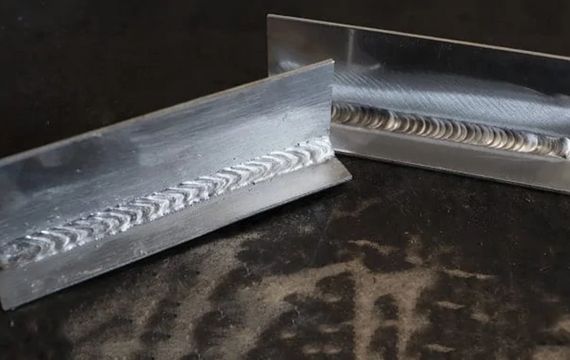
Some of the differences between MIG vs TIG welding include:
Power Source
MIG welding utilizes a DC power source. This is because it requires the current to pass to the material being welded through the wire source.
On the other hand, TIG welding utilizes both DC and AC power sources. Both AC and DC power sources are ideal especially when working on different metals.
Metal Selection
TIG welding is preferable when dealing with thin metals.
The main reason for this is that it is easy to control the heat using the TIG welding process compared to the MIG welding process.
On the other hand, the MIG welding process is majorly preferred when welding thick metals.
Electrode
MIG welding utilizes consumable electrodes that act as fillers and also create electric arcs.
The electrodes are mostly made from steel or nickel steel.
TIG welding utilizes non-consumable electrodes which do not melt but only create electric arcs.
The non-consumable electrodes are majorly made from tungsten and copper-coated carbon.
Shielding Gases
MIG vs TIG welding gas, Both TIG welding and MIG welding defer in the type of shielding gas that is used.
MIG welding mainly uses oxygen as a shielding gas while TIG welding applies argon as a shielding gas.
The different gases used for the two welding processes is as a result of the material welded.
Welding Torch
A welding torch is used to hold the electrodes in place during the welding process.
For a welding torch to function well, it must be cooled down. Welding torches can either be water-cooled or air-cooled.
MIG welding mostly applies air-cooled torches while the TIG welding process uses water-cooled welding torches.
Welding Quality
The TIG welding process produces better quality sheet metal fabrications compared to the MIG welding process.
Remember, the overall quality output of the TIG welding process is clean and aesthetic finish.
Speed
TIG welding is labor intensive and also requires keenness to detail while using the process. This makes it slow and cumbersome.
The MIG welding process is straightforward to use. This makes it a fast process compared to the TIG welding process.
Cost
MIG vs TIG welding cost, the MIG welding process is a cheaper welding option compared to the TIG welding process.
What , akes the TIG welding process expensive is the quality of welding, the material used, and the higher cost of electricity it utilizes.
TIG Welding Applications

TIG welding is ideal in applications that utilize thin materials. This is because it is easy to control the heat using the TIG welding method.
Materials that can easily warp or burn are ideal for the TIG welding process.

The TIG welding method requires precision and experience. It is mainly applied in jobs that required highly skilled welders and also jobs that require more detail.

TIG welding is mainly applied in jobs that require bench work. The main reason for this is that the TIG process is not as flexible as other welding processes.

TIG welding process is known for its quality and clean piece of work. It can be used in applications such as automotive restoration and restoration of fine artwork.
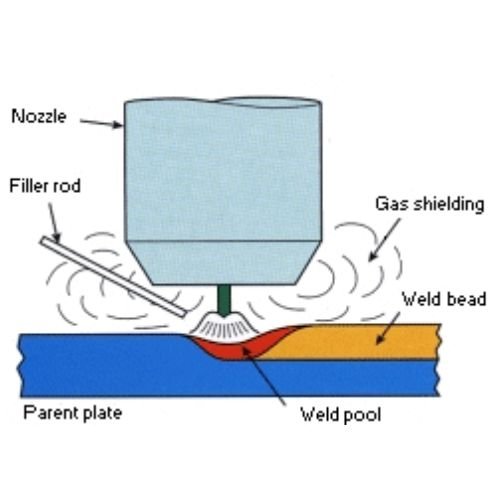
TIG welding can also be applied in applications that require short runs for example welding of pipe joints.
MIG Welding Applications
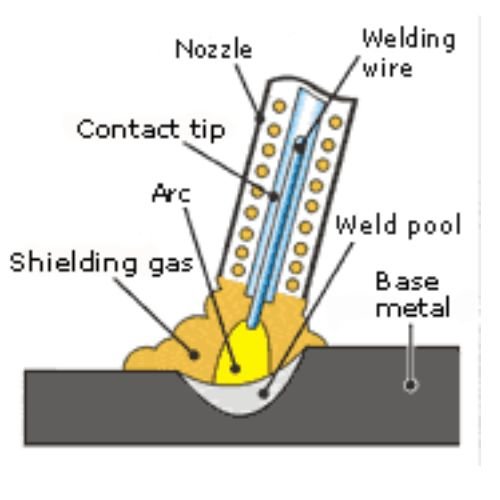
MIG welding uses a continuous electrode in welding. This allows for long runs because of the continuously fed wire. It also ensures that there are minimal defects.

MIG welding is ideal for welding tight positions that are difficult to reach. This is because you have one free hand, unlike the TIG welding process.

The MIG welding process allows for high output because it is simple to use and also requires minimal skill.
The MIG welding process is the preferable welding process when you require high production rates.
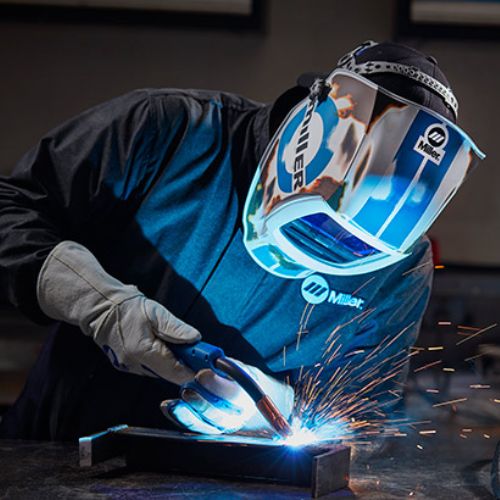
You do not require high experience or pieces of training to use the MIG welding process.
This allows for easy completion of projects and also allows for a wide range of applications.
People Also Ask:
MIG welding tends to be a better and faster welding method as compared to TIG and thus is suited for tasks that need higher rates of production.
TIG welding on the other hand is suited for metals that are thin and small projects as it produces welds that are clean and precise.
MIG tends to be relatively affordable as it is a faster welding process that has parties that are easily available and cheaper than TIG.
TIG on the other hand tends to have a lower deposition rate thus it is costly per foot of bead.
TIG is the hardest type of welding as compared to MIG because it needs a lot of operational control. Additionally, there is a need for technical expertise in manually feeding the filler material to the production system.
More Resources:
MIG vs TIG welding for beginners
MIG vs TIG welding vs stick
MIG vs TIG welding gloves
MIG vs TIG welding for cars
Arc vs MIG vs TIG welding



